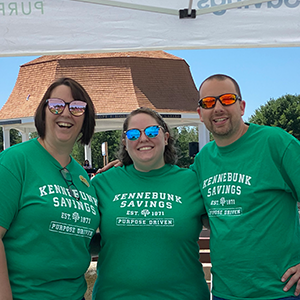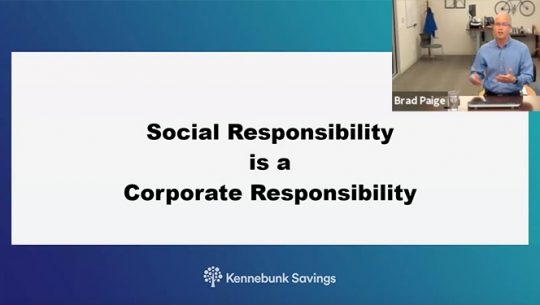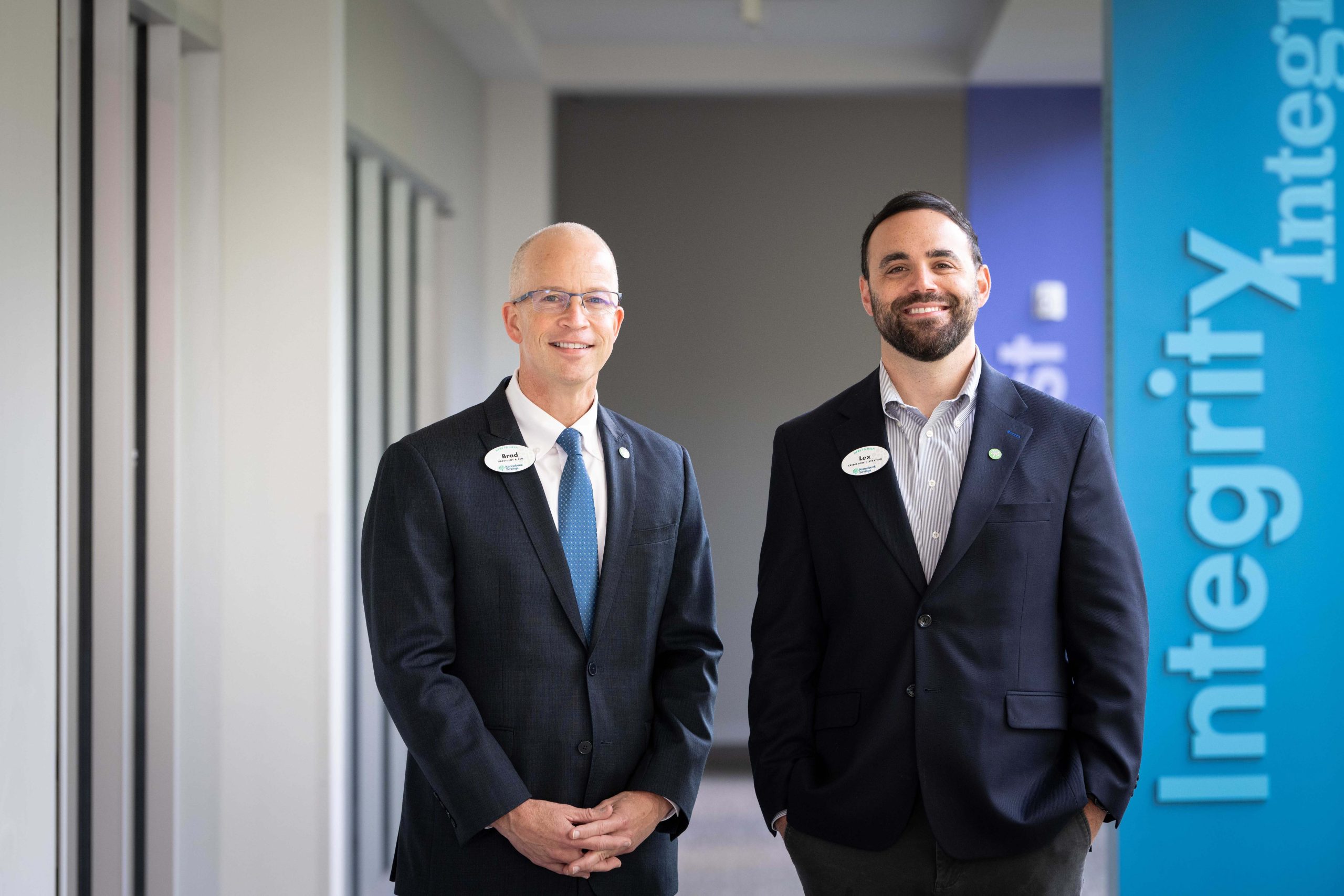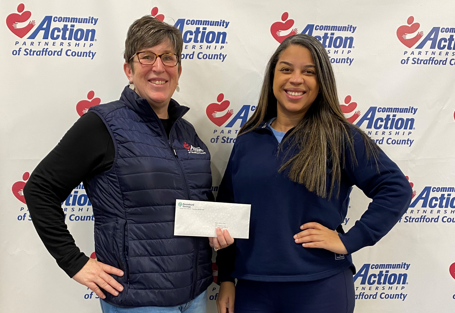“We really value the strong relationship we have with the team at SOS Recovery Community Organization,” said Bradford C. Paige, President and CEO of Kennebunk Savings. “We lose too many members of our communities each year – friends, neighbors and relatives – to preventable overdose deaths. We need to push the boundaries of our response to this crisis.”
Kennebunk Savings has been a longtime supporter of several nonprofits working in the field of substance use disorder, and has made several significant donations to SOS since 2018, including funding development of their recovery coach curriculum, “The Art and Science of Peer-Assisted Recovery.” Paige was a presenter at this year’s conference, speaking about how businesses could get more involved in supporting recovery and prevention, and providing advice to nonprofits seeking such partnerships.
SOS Recovery Community Organization, led by Director John Burns, is a collaborative of peers in recovery from substance use disorder and their allies working together to create safe spaces and peer-based recovery supports throughout Strafford and Rockingham Counties, NH. SOS and its Recovery Community Centers exist to bolster and grow the local recovery community through: recovery coaching, crisis response, telephone recovery support, workshops, advocacy, partnerships with diverse community organizations and more.
“Innovations in Recovery” was held on October 8th & 9th, 2020. Day 1 keynote speakers included Donna Jackson Nakazawa, acclaimed journalist and author of “The Angel and the Assassin: The Tiny Brain Cell That Changed the Course of Medicine,” who shared the latest on neuroscience and developmental disruptions in childhood. She emphasized “giving parents the skills to manage their own stuff” – confronting the impact of trauma and stress before it can be passed on to the next generation.
Toxic stress occurs when stress response systems are overtaxed, which can be particularly dangerous for young children, having an adverse impact on their developing brain, immune system, metabolic system and cardiovascular system. Toxic stress early in life can lead to negative health outcomes later in life, including substance use disorder.
Cheryle Pacapelli, director of HOPE for New Hampshire Recovery, presented on the progress of programs in the granite state, and Shannon Bresaw and Mary Boisse detailed their Recovery Friendly Workplace initiative, which is gaining momentum all over New England.
Dean LeMire and John Iudice presented on harm reduction, the name given to policies and practices aimed at reducing the negative health, legal and social issues associated with drug use and drug laws. Harm reduction is focused on working with people and meeting them where they are without judgment or preconditions. The stigma around substance use disorder is more dangerous than many people know. Studies have shown that individuals in need of healthcare received measurably worse treatment when referred to with derogatory terms such as “addict” or “junkie.” The approach to language in this field is always evolving; LeMire and Iudice even cautioned against the language of disease and disorder. Defining addiction as a relationship, they argued, was more helpful for empowering individuals to meet the goals they set for themselves.
Author Maureen Cavanaugh shared her personal and familial journey on the road to recovery, and Tom Coderre of the Substance Abuse and Mental Health Services Administration (SAMHSA) provided an update on their recent work. SAMHSA is a subagency of the US Department of Health and Human Services, and works to reduce the impact of substance use disorder on America’s communities.
This year marked the inaugural presentation of the Art Woodard Award for Diversity, Equity and Inclusion. The late Art Woodard was a mentor to many in the recovery community and the award was given to his friend and collaborator, Jim Wuelfing. Art Woodard passed away from complications after a heart transplant on October 5th; plans were made to create the award prior to his untimely passing. SOS Director John Burns called Woodard “a gentle and compassionate soul.”
On Day 2, national speaker and advocate Ryan Hampton (author of “American Fix”) spoke passionately about the necessity for grassroots organizing to effect political change. Brendan Cox shared a perspective from the cutting edge of law enforcement. The Law Enforcement Assisted Diversion (LEAD) program trains and allows police officers at “point of contact” to divert individuals into community-based intervention rather than the traditional criminal justice system. After a promising test program in Seattle, the LEAD model is being explored in jurisdictions across the country.
A panel including LeMire, Wuelfing, and Michelle Reilly discussed training development for Peer-Assisted Recovery Supports, which are services that support an individual in recovery by providing a safe space without a power differential. Hearing from someone with lived experience in recovery, or an affected family member or trained ally, can be particularly helpful to those who are struggling to meet their recovery goals.
Macro social worker and recovery scientist Robert Ashford presented his in-depth research on “How Community and Peers Transform the Movement.” Justice Rivera, Carol Cruz, Djemi Lazarre, and Claudia Delfin then conducted a panel discussion on Inclusion and Diversity, and closing remarks were delivered by Tym Rourke, Director of the New Hampshire Charitable Foundation’s “New Hampshire Tomorrow” initiative.
Though initially planned as an in-person conference, John Burns pointed out that the virtual delivery was thematically significant. Virtual recovery supports have allowed the team at SOS to reach people in need of help that may not have sought it out before. “We are now reaching people who would never have set foot in a recovery center.” When the pandemic first hit, Burns said, “we advanced our technology and our entire business model ahead by about three years—in three days.” When the pandemic is over, in-person work at SOS centers will return to normal, but the digital supports will not go away, either. “Yeah, we’re gonna have a little more to do,” Burns laughed.
###
About Kennebunk Savings
Kennebunk Savings’ Spotlight Fund was created in 2016 to focus a dedicated portion of the bank’s charitable giving toward critical issues affecting our community. For the past three years, that focus has been on combating substance use disorder. In 2020, Kennebunk Savings has committed to donating $150,000 to nonprofits working toward both Community Education and reducing the barriers faced by people in recovery as they reenter the workforce.



